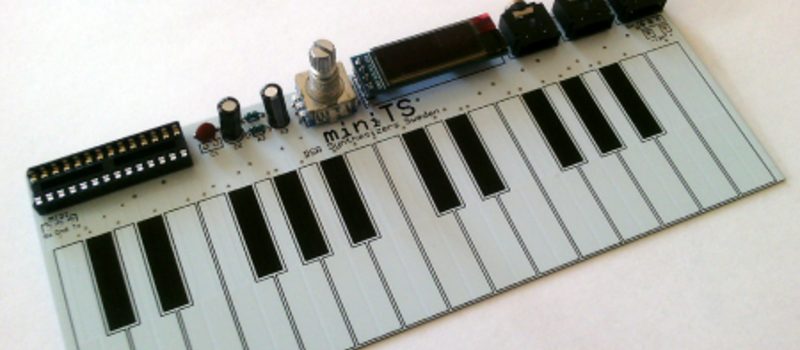[Jan Ostman] has been pushing the limits of sound synthesis on the lowly AVR ATMega microcontrollers, and his latest two project is so cute that we just had to write it up. The miniTS shares the same basic sound-generation firmware with his previous TinyTS, which we’ve covered here before, but adds a lot more keys, an OLED, and MIDI, while taking away some of the knobs.
Both feature keyboards that are just copper pads placed over a ground plane, and the code does simple capacitive-sensing to figure out if they’re being touched or not. The point here is that you could pick up a PCB from [Jan] on the cheap, and experiment around with the code. Or you could just take the code and make a less refined version for yourself with a cheapo Arduino and some copper plates.
Either way, we like the combination of minimal materials and maximum tweakability, and think it’s cool that [Jan] shares the code, if not also the PCB designs. Anyone with PCB layout practice could get a clone worked up in an afternoon, although it’s going to be cheaper to get these made in bulk, and you’re probably better off just buying one from [Jan].
















No video?
Janost is unreliable. he’s now pushing the next project and still hasn’t delivered his Kickstarter for the last one.
But people keep giving him money, why change?
Hopefully this goes better than the last funded project. I waited two years without reply after putting into the coffers…
Cool looking project though.
muffwiggler is full of such stories about this guy
Thanks for the heads up. I was wondering if it was “just me” kinda thing but it seems like it did go the way I experienced. Just wow.
I didn’t even see the comment where he called HaD users a bunch of grumpy bitches and then flouts his “success”. Can’t believe I gave this anus money but easy to correct in the future.
Code is a bit broken on github:
TCCR1B =
// Fast PWM
mode.
(1 <<
WGM12) | (1 << WGM13) |
// No clock
prescaling (fastest possible
// freq).
(1 <<
CS11);
The last time I saw Jan post here, he when batshit crazy at Brain, essentially accused him of shilling someone elses synth creation
“Why is it that you, Brian, gets to write about these thing you have no knowledge or experience about?
I dont think youre even musical.
It just plain destroys the rep of HaD.”
http://hackaday.com/2017/02/24/a-mess-of-wires-turned-into-an-analog-synth/#comments
^
FWIW, I backed the Tiny-TS fundraiser and received my (unpopulated) board last month. My only complaint has been a kinda vague BOM, but I chalked that up to my inexperience.
woa, good thing I read the comments; I was all over this … before learning about Jan
This is nothing special, it’s just an Arduino with audio output and a capacitive keyboard. However, if you want to experiment with digital audio AVRs are a bit underpowered. I suggest a fairly beefy ARM microcontroller (e.g. STM32s or a Teensy, which has some nice audio libraries) or some old piece of hackable hardware, such as the Nintendo DS (it has 16 HW channels, a microphone and WiFi for MIDI connection).
I had to laugh when reading everyone marveling over the touch keyboard as if they had never heard of the capsense library as well.
Search muff wiggler DIY forums for “Jasper” a great clone of the WASP. It has a capacitive keyboard, but trivial to make a midi interface if that’s your bag.
https://www.muffwiggler.com/forum/viewtopic.php?t=151625
Muff wiggler DIY section has some amazing projects/DIY products, this isn’t one of them.
Well, I ordered one of the bare boards, so I don’t have much cash into it.
Please let us know how it goes. Would like to see him pull his act together.